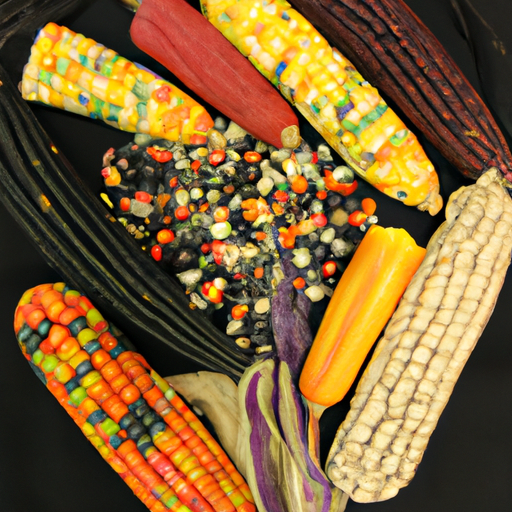Step into the world of Native American cuisine and embark on a flavorful journey through indigenous foodways. Tastepan.com invites you to explore a diverse and rich tapestry of food culture and traditions. Discover the fascinating culinary histories and regional cuisines that have shaped the indigenous communities across the Americas. Immerse yourself in the authentic flavors and ingredients that have been passed down for generations, and gain a deeper appreciation for the unique and vibrant heritage of Native American cuisine.

History of Native American Cuisine
Native American cuisine has a long and vibrant history that dates back thousands of years. Before the arrival of European colonizers, indigenous peoples had developed intricate food systems and culinary traditions that were deeply rooted in their culture and environment. The history of Native American cuisine can be divided into three distinct eras: the Pre-Columbian era, the impact of European colonization, and the resurgence of indigenous foodways.
Pre-Columbian Era
In the Pre-Columbian era, Native American tribes across the continent cultivated a wide variety of crops and utilized an array of cooking techniques. One of the most significant contributions to Native American cuisine during this time was the “Three Sisters” agricultural system, which consisted of corn, beans, and squash. These three crops were grown together in a symbiotic relationship, with each plant providing essential nutrients for the others. This agricultural practice not only sustained the tribes but also shaped their cuisine.
Impact of European Colonization
With the arrival of European colonizers in the 15th century, Native American cuisine underwent profound changes. The introduction of new ingredients, such as wheat, rice, and livestock, had a significant impact on Native American foodways. Native peoples began integrating these new ingredients into their traditional dishes, creating fusion cuisines that blended traditional indigenous flavors with European influences. This period also brought devastating consequences for Native American food culture, as many traditional foods and cooking techniques were replaced or lost.
Resurgence of Indigenous Foodways
In recent years, there has been a resurgence of interest in and appreciation for indigenous foodways. Native American communities across North America have been reclaiming their culinary heritage, revitalizing traditional dishes, and promoting sustainable and locally sourced ingredients. This resurgence not only preserves Native American food culture but also strengthens community ties and fosters cultural identity.
Traditional Native American Foods
The traditional Native American diet was diverse and varied, reflecting the rich tapestry of indigenous cultures across the continent. Here are some key elements of Native American cuisine:
Corn, Beans, and Squash – The Three Sisters
As mentioned earlier, corn, beans, and squash formed the backbone of many Native American cuisines. The Three Sisters provided essential nutrients and complemented each other’s growth patterns. Corn was a staple crop, used to make bread, porridge, and tortillas. Beans added protein to the diet, and squash provided vitamins and minerals.
Wild Game
Native Americans relied heavily on hunting wild game for sustenance. Deer, bison, elk, and rabbit were among the most commonly hunted animals. The meat would be prepared in various ways, including stewing, roasting, or drying for preservation. Venison jerky, for example, was a staple for many tribes during leaner times of the year.
Fish and Seafood
For tribes living near rivers, lakes, and coastal areas, fish and seafood played a vital role in their diet. Salmon, trout, clams, mussels, and crabs were commonly caught and incorporated into Native American dishes. Smoking and drying were popular preservation methods for fish, allowing tribes to store them for longer periods.
Edible Plants and Berries
Native Americans had an extensive knowledge of edible plants and berries that grew in their local environments. They would forage for items such as wild onions, cattails, berries, and nuts, incorporating them into salads, soups, or as side dishes. These plants provided important vitamins, minerals, and phytonutrients to their diets.

Cooking Techniques and Tools
Native American cuisine was characterized by a range of unique cooking techniques and tools. These methods allowed tribes to make the most of their natural resources and create flavorful and nourishing meals. Some notable techniques and tools include:
Pit Cooking
Pit cooking, also known as earth oven cooking, involved digging a shallow pit in the ground, lining it with hot rocks, and layering it with food. The pit would then be covered with leaves, earth, or bark, and the food would slow-cook in the earth’s heat. This method was commonly used for roasting and baking meats, vegetables, and even bread.
Hot Stone Cooking
Hot stone cooking was another prevalent technique among Native Americans. Smooth river stones would be heated in a fire and then used to cook or bake food. The stones were either submerged in liquid, creating a boiling effect, or placed directly on the food to cook it through. This method allowed for precise control of temperature and even cooking.
Smoking and Drying
Smoking and drying were vital preservation methods used by Native Americans. Fish, meat, and even fruits and vegetables were smoked or dried to remove moisture and increase their shelf life. Smoking meat, in particular, added a distinct smoky flavor that helped to preserve the food and enhance its taste.
Clay Pots and Ceramic Cooking
Clay pots and ceramic cooking vessels were commonly used in Native American cuisine. These pots were durable and efficient at retaining and distributing heat. They were used for simmering soups, stews, and various dishes. The porous nature of clay pots also allowed flavors to meld, resulting in delicious and aromatic meals.
Regional Differences in Native American Cuisine
Native American cuisine exhibits significant regional diversity, with each geographical area having its own distinct culinary traditions. Here are some examples of regional differences in Native American cuisine:
Southwest
The cuisine of the Southwest is characterized by its use of corn, beans, and squash, which are staple ingredients in many traditional dishes. The introduction of Spanish colonization brought ingredients like tomatoes, chilies, and wheat, which integrated into Native American cooking. The cuisine of the Southwest showcases flavors and techniques from both indigenous and European influences.
Great Plains
The Great Plains region is known for its reliance on buffalo as a primary food source. Buffalo meat was consumed in various forms, such as roasted, dried, or ground into pemmican. The plains tribes also foraged for wild berries and utilized other available food resources, such as roots and tubers.
Northeast
The Northeastern tribes had access to an abundance of seafood, thanks to their proximity to the Atlantic Ocean and numerous rivers. Seafood, including fish, clams, and lobsters, played a crucial role in their diet. The region is also known for the cultivation of corn, beans, and squash, which formed the basis of many traditional dishes.
Northwest Coast
The tribes of the Northwest Coast relied heavily on fish and seafood, thanks to the abundance of rivers, lakes, and the Pacific Ocean. Their cuisine featured a wide variety of fish, including salmon, halibut, and shellfish like clams and oysters. Potlatches, elaborate feasts, were an important cultural practice in this region, and they showcased the wealth and generosity of the hosts.

Traditional Native American Dishes
Native American cuisine boasts a diverse array of traditional dishes, each with its own unique flavors and cultural significance. Here are some notable examples:
Frybread
Frybread is a popular Native American dish that originated in the United States. It is made by frying a simple dough made with flour, salt, baking powder, and water. The result is a fluffy and slightly crispy bread that can be served with various toppings, such as honey, powdered sugar, or savory fillings like taco ingredients.
Pemmican
Pemmican is a high-energy food traditionally made by Native Americans as a portable and long-lasting source of sustenance. It is typically made from dried lean meat, such as buffalo, mixed with rendered animal fat and dried fruit. Pemmican has a high calorie content and remains edible for long periods, making it an ideal food for travel or survival situations.
Cornbread
Cornbread is a classic Native American dish that has become a staple in American cuisine. It is made by combining cornmeal with other ingredients like flour, sugar, eggs, and milk or buttermilk. Cornbread can be baked in a cast-iron skillet or muffin tin and is often served as a side dish with stews, chili, or barbecue.
Wild Rice
Wild rice holds great cultural significance for many Native American tribes, particularly those in the Great Lakes region. It is a long-grain aquatic grass that grows in lakes and rivers. Wild rice has a nutty flavor and is often used as a base for soups, salads, or served as a side dish. Its importance in Native American cuisine is deeply rooted in traditional harvesting and processing methods.
Salmon with Cedar Plank
Salmon was and continues to be a revered food source for Native American tribes in the Pacific Northwest. One traditional cooking method is grilling salmon fillets on a cedar plank, which imparts a smoky and aromatic flavor to the fish. This method not only adds depth of flavor but also reflects the deep connection between the tribes and their environment.
Cultural Significance of Native American Cuisine
Native American cuisine goes beyond mere sustenance; it holds profound cultural significance for indigenous communities. Here are some aspects of this significance:
Spiritual and Ceremonial Practices
Food plays a central role in Native American spiritual and ceremonial practices. Many traditional ceremonies involve the offering of food to deities, ancestors, or spirits. The preparation and consumption of certain foods are part of sacred rituals, symbolizing the connection between humans, nature, and the spiritual realm. Such practices foster a sense of unity, gratitude, and respect for the natural world.
Community and Kinship
Native American cuisine has always been intertwined with communal and familial gatherings. Sharing meals fosters a sense of community and kinship, bringing people together to celebrate, strengthen social bonds, and pass down cultural traditions from one generation to another. The act of coming together to prepare and share food is a powerful way to forge connections and nurture relationships within indigenous communities.
Preservation of Cultural Identity
Native American cuisine serves as a vehicle for preserving and celebrating cultural identity. By revitalizing and promoting traditional foodways, indigenous communities honor the wisdom, knowledge, and heritage of their ancestors. It is through the revival of traditional dishes and culinary practices that indigenous peoples reclaim their cultural identity and reinforce a sense of pride and belonging.
Challenges and Revival of Native American Cuisine
Despite the resilience of Native American cuisine, there have been challenges in preserving and promoting indigenous foodways. Here are some key challenges and the efforts made to address them:
Loss of Culinary Knowledge
Due to a long history of colonization and forced assimilation, many Native American communities experienced the loss of culinary knowledge and traditions. Elders who held essential culinary knowledge often faced significant barriers in passing down their skills and recipes to younger generations. The loss of this knowledge threatened the preservation of traditional Native American cuisine.
Efforts are being made to document and revitalize traditional cooking techniques, ingredients, and recipes through initiatives such as community-led cooking workshops, oral history projects, and the recording of elders sharing their culinary knowledge. These efforts not only restore the knowledge but also empower future generations to carry forward their culinary traditions.
Health Concerns
In recent years, Native American communities have faced significant health challenges, including a higher prevalence of chronic diseases such as diabetes and obesity. These health concerns have been further exacerbated by the prevalence of processed foods and the limited availability of fresh, traditional ingredients.
Efforts to address these health concerns include promoting the consumption of traditional foods and ingredients that are naturally nutrient-rich and low in fat and sugar. By reintroducing traditional foods into diets and promoting indigenous food sovereignty, Native American communities can improve their health outcomes and reconnect with their cultural heritage.
Efforts to Preserve and Promote Indigenous Foodways
Native American communities and organizations have been actively working to preserve and promote indigenous foodways. They are engaging in initiatives such as seed-saving programs, sustainable farming practices, culinary education, and the revitalization of traditional ingredients and cooking techniques. These efforts not only serve to restore and maintain cultural practices but also provide economic opportunities for tribal communities.
Through partnerships with educational institutions, government agencies, and non-profit organizations, Native American communities are reclaiming their food sovereignty, asserting control over their traditional food systems, and ensuring the survival and vibrancy of their culinary heritage.
Adaptation and Fusion with Modern Cuisine
Native American cuisine has also been adapting and influencing contemporary culinary trends. Native American chefs and food entrepreneurs have taken the opportunity to showcase indigenous ingredients, techniques, and flavors in a modern context. They are at the forefront of culinary innovation, blending traditional and contemporary elements to create unique and exciting dishes.
Native American Ingredients in Contemporary Dishes
Native American ingredients such as wild rice, sunchokes, chokeberries, and bison are finding their way into contemporary fusion dishes. Chefs are incorporating these ingredients into a wide range of cuisines, creating new flavor profiles and culinary experiences. Native American traditional flavors are being embraced and appreciated by a wider audience, leading to a greater recognition of indigenous culinary contributions.
Native American Chefs Leading Culinary Innovations
Native American chefs are reclaiming their space in the culinary world and challenging stereotypes and misconceptions about indigenous cuisine. They are using their skills, knowledge, and creativity to introduce indigenous ingredients and cooking techniques to a broader audience. By leading culinary innovations, these chefs are not only promoting indigenous foodways but also educating others about the rich culinary heritage of Native American cultures.
Exploring Native American Food Traditions
For those interested in exploring Native American food traditions, there are several ways to engage with and learn about indigenous culinary practices:
Participating in Native American Food Festivals
Native American food festivals provide an immersive experience where visitors can taste traditional dishes, witness cooking demonstrations, and learn from indigenous chefs and culinary experts. These festivals often feature a range of Native American cuisines from various regions, allowing participants to discover the diverse flavors and traditions of Native American food.
Visiting Indigenous-owned Restaurants and Cafes
Indigenous-owned restaurants and cafes offer a unique dining experience that showcases traditional Native American dishes alongside modern interpretations. These establishments not only serve delicious food but also provide an opportunity to directly support indigenous entrepreneurs and their communities.
Learning Native American Cooking Techniques
Many organizations and institutions offer workshops and classes that teach Native American cooking techniques and traditional recipes. These opportunities allow participants to gain hands-on experience with ingredients and cooking methods that have been passed down through generations. Learning about Native American cuisine directly from indigenous chefs and cooks provides a deeper understanding and appreciation for their culinary traditions.
The Future of Native American Cuisine
The future of Native American cuisine holds great promise as indigenous communities strive to reclaim and celebrate their food culture. Two key areas of focus for the future are sustainability and building bridges through food and cultural exchange.
Sustainability and Indigenous Food Sovereignty
The promotion of sustainable agricultural practices and the protection of traditional food systems are vital for the future of Native American cuisine. Sustainable farming, seed-saving programs, and the cultivation of traditional ingredients contribute to biodiversity, environmental stewardship, and the preservation of cultural heritage. By asserting food sovereignty, Native American communities can regain control over their food systems and ensure the longevity of their culinary traditions.
Building Bridges through Food and Cultural Exchange
Native American cuisine has the power to foster understanding, respect, and cultural exchange. Building bridges between indigenous and non-indigenous communities through food not only promotes cross-cultural dialogue but also strengthens the economic, social, and cultural connections between diverse populations. By sharing their culinary traditions, indigenous communities can create opportunities for appreciation, collaboration, and empowerment.
In conclusion, Native American cuisine is a rich tapestry of flavors, ingredients, and cooking techniques that reflect the diverse cultures and environments of indigenous peoples. The history, traditional foods, and cultural significance of Native American cuisine emphasize the deep connection between food, community, and cultural identity. Efforts to preserve and promote indigenous foodways are vital for the revitalization of Native American culinary traditions and the well-being of indigenous communities. As the future unfolds, the sustainability of traditional food systems and the culinary innovations of Native American chefs will continue to shape and celebrate the vibrant heritage of Native American cuisine.

